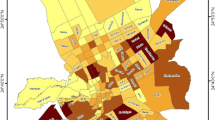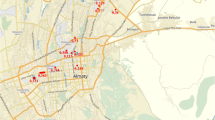Abstract
The requirement for various rural households to identify emerging pollutants has resulted in a paradigm shift toward health-related concerns. Due to poor sanitary conditions, low-income people have unintentionally aided in environmental degradation. In this paper, the health status of individuals was assessed using statistical analysis of data gathered from regional households in Karnataka. A sample of Water, Wastewater, Solid-Waste Management and Indoor Air Pollution parameters of house circumstances prevalent in the study area. The emerging pollutant has been identified for each category, pointing to 'Poverty' as the primary cause of deteriorating rural household conditions. The study's findings revealed a strong relationship between pollution and poor health in the low-income population. According to the authors, this investigation will help the government's Swachh Bharat Mission.










Similar content being viewed by others
References
Barnes B, Mathee A, Thomas E and Bruce N 2009 Household energy, indoor air pollution and child respiratory health in South Africa. J. Energy South. Afr. 20(1): 4–13
Edokpayi J N, Odiyo J O and Durowoju O S 2017 Impact of Wastewater on Surface Water Quality in Developing Countries: A Case Study of South Africa. In (Ed.), Water Quality. IntechOpen. https://doi.org/10.5772/66561
Krishnan M, Bhowmik B, Hazra B and Pakrashi V 2018 Real time damage detection using recursive principal components and time varying auto-regressive modeling. Mech. Syst. Signal Process. 101: 549–574
Rathnamala G V, Ashwini N and Babitha 2021 Domestic environmental destructions due to lack of solid waste management in rural areas. Adv. Math. Sci. J. 10(3): 1807–1819
Mucchielli P, Bhowmik B, Hazra B and Pakrashi V 2020 Higher-order stabilized perturbation for recursive eigen-decomposition estimation. J. Vib. Acoust. 142(6): 061010s
Shylaja N, Ashwini R M and Babu E R 2022 September. Seismic analysis of diagrid structure on sloping ground. In IOP Conference Series: Materials Science and Engineering 1255(1): p. 012008. IOP Publishing
Bhowmik B, Tripura T, Hazra B and Pakrashi V 2020 Real time structural modal identification using recursive canonical correlation analysis and application towards online structural damage detection. J. Sound Vib. 468: 115101
Rashid M and Pandit D 2019 Determining the provision of wastewater management infrastructure in rural India from the local communities’ perspectives. Water Sci. Technol. 79(3): 489–500
Fewtrell L, Kaufmann R B, Kay D, Enanoria W, Haller L and Colford J M Jr 2005 Water, sanitation, and hygiene interventions to reduce diarrhoea in less developed countries: a systematic review and meta-analysis. Lancet Infect. Dis. 5(1): 42–52
Dales R E, Miller D and McMullen E D 1997 Indoor air quality and health: validity and determinants of reported home dampness and moulds. Int. J. Epidemiol. 26(1): 120–125
Gowda S 2010 Rural to Urban Migration and Household Environmental Problems in Slums of Bangalore. Doctoral dissertation. PES College of Engineering, Karnataka, India
Esrey S A, Feachem R G and Hughes J M 1985 Interventions for the control of diarrhoeal diseases among young children: improving water supplies and excreta disposal facilities. Bull. World Health Organ. 63(4): 757
Kumar Karn S and Harada H 2002 Field survey on water supply, sanitation and associated health impacts in urban poor communities – a case from Mumbai City, India. Water Sci. Technol. 46(11–12): 269–275
Kumar M and Puri A 2012 A review of permissible limits of drinking water. Indian J. Occup. Environ. Med. 16(1): 40–44
Shivashankara G P 2011 Household environmental problems in developing countries. WIT Trans. Ecol. Environ. 153: 287–298
Murali M and Rani B S 2005 Some studies on impact of integrated low cost sanitation of ground water quality at Jodugullapalem Slum Area, Visakhapatnam, India. Pollut. Res. 24(1): 35
Goldemberg J, Martinez-Gomez J, Sagar A and Smith K R 2018 Household air pollution, health, and climate change: cleaning the air. Environ. Res. Lett. 13(3): 030201
Gowda S and Shivashankara G P 2007 Rural migration to the Indian metropolis: case study Bangalore. ITPI J. 4(1): 67–69
Dhawde R, Surve N, Macaden R, Wennberg A C, Seifert-Dähnn I, Ghadge A and Birdi T 2018 Physicochemical and bacteriological analysis of water quality in drought prone areas of Pune and Satara Districts of Maharashtra, India. Environments. 5(5): 61
Karambelas A, Holloway T, Kinney P L, Fiore A M, DeFries R, Kiesewetter G and Heyes C 2018 Urban versus rural health impacts attributable to PM2.5 and O3 in northern India. Environ. Res. Lett. 13(6): 064010
Ashwini R M, Rathnamala G V, Kumar G D and Manikiran M 2020 Dynamic analysis of Rc frame structure with & without infill when subjected to seismic load. Solid State Technol. 63(5): 1961–1971
Dandabathula G, Bhardwaj P, Burra M, Rao P V P and Rao S S 2019 Impact assessment of India’s Swachh Bharat Mission-Clean India Campaign on acute diarrheal disease outbreaks: yes, there is a positive change. J. Fam. Med. Primary Care 8(3): 1202
Jangra B, Majra J P and Singh M 2016 Swachh Bharat Abhiyan (clean India mission): SWOT analysis. Int. J. Commun. Med. Public Health. 3(12): 3285–3290
Behera B, Das M and Rana G S 2012 Studies on ground water pollution due to iron content and water quality in and around, Jagdalpur, Bastar district, Chattisgarh, India. J. Chem. Pharm. Res. 4(8): 3803–3807
Gowda S and Shivashankara G P 2008 Environmental impact assessment of urban sums in Bangalore agglomerations. ITPI J. 5(2): 19–25
Bhowmik B, Tripura T, Hazra B and Pakrashi V 2019 First-order eigen-perturbation techniques for real-time damage detection of vibrating systems: Theory and applications. Appl. Mech. Rev. 71(6): 060801
Rathnamala G V 2020 Analysis of drinking water quality and mode of storage in Dodballapur Taluk. Solid State Technol. 63(5): 945–957
Rathnamala G V and Shivashankara G P 2022 An evidence-based approach towards identifying household emerging pollutants in rural areas in Southern Karnataka. J. Water Sanit. Hyg. Dev. 12(6): 498–516
Shivashankara G P and Gowda Sidde 2010 Determinants of rural to urban migration and environmental problems. OIDA Int. J. Sustain. Dev. 1(07): 99–106
Kumar V, Bharti P K, Talwar M, Tyagi A K and Kumar P 2017 Studies on high iron content in water resources of Moradabad district (UP), India. Water Sci. 31(1): 44–51
Ashwini R M, Potharaju M, Srinivas V, Kanaka Durga S, Rathnamala G V and Paudel 2023 A compressive and flexural strength of concrete with different nanomaterials: a critical review. J. Nanomater. 2023: 1004597
Rathnamala G V, Shivashankara G P, Ashwini R M, Rashmi H R and Bhowmik B 2023 A health risk model for rural households based on the distribution of multi pollutants. Water Sci. Technol. 87(7): 1686–1702
Author information
Authors and Affiliations
Corresponding author
Rights and permissions
About this article
Cite this article
Rathnamala, G.V., Shivashankara, G.P. A multi-criteria emerging pollutant analysis using statistical markers in rural areas of Karnataka State, India. Sādhanā 48, 145 (2023). https://doi.org/10.1007/s12046-023-02217-w
Received:
Revised:
Accepted:
Published:
DOI: https://doi.org/10.1007/s12046-023-02217-w




